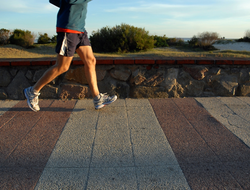Physical activity and exercise: a prescription for health
Published: April 08, 2021
It has been known for decades that regular exercise or physical activity is associated with many health benefits.
More than two thousand years ago, Aristotle recognised and wrote about the health benefits of regular exercise not onlyfor maintaining a healthy body and living longer.
He also observed were mental health benefits were also associated with regular physical activity.
Until the middle of the 20th Century physical activty, for most people, was a fact of life.
People walked from A to B, used public transport where it was available, and generally led active lives.
Why be active?
With the arrival of energy and time saving technology physical activity levels of people living in westernised societies have dwindled.
Simultaneously there has been a significant increase in the incidence of chronic disease.
While lack of exercise or physical activity is not the only risk factor for the development of any of a number of chronic diseases, scientific evidence increasingly indicates that various types of physical activity and exercise promote health and wellness.
It is not a secret that regular physical activity can:
- decrease the risk of heart disease in its many forms, high blood pressure, cancer, type 2 diabetes, arthritis, and osteoporosis
- reduce the effects of aging
- increase lean body mass
- help maintain a healthy body weight, and reduce the health risks associated with being overweight or obese
- improve mental output and reduce cognitive degeneration
- maintain and/or improve strength functional capacity
Overall improvement in physiological and psychological benefits can improve quality of life, and from a socio-economic perspective reduce health care costs.
Reducing healthcare costs is a problem faced by most Western countries in which large aging populations are putting increasing demands on limited funds.
It is not only the aging population that is a cause for concern.
Reduced physical activity levels, along with poor nutrition habits, in children, adolescents and younger adults contribute to the increased incidence of obesity and chronic disease.
This has the potential to increase the demand for health services.
Regular physical activity and exercise can reduce the risk of and ameliorate nearly all chronic diseases.
However, until recently, physical activity and exercise have generally been ignored as a way to improve health.
How much exercise a patient performs each day is not a question that physicians are expected to routinely ask in the same way physicians record blood-pressure measurements.
And yet regular physical activity can have a positive effect on maintaining a healthy blood-pressure.
Who can get the message out?
While many physicians may advise their patients to get some exercise only a few enlightened physicians actually prescribe exercise in terms that the patient can act on.
There are many reasons why physicians do not prescribe or even discuss exercise as a part of patient's health plan.
Where healthcare is state funded the time a physician spends with any one patient may be limited.
However, advocates for including physical activity in a patients overall treatment suggest that it doesn't take long to discuss the benefits of exercise.
Where healthcare practitioners do recognise the health benefits of exercise, their expertise may not extend to, and cannot be expected to extend to, physical activity and exercise program design.
Who can these health care practitioners turn to when they want to prescribe exercise to their patients?
Exercise physiologists and personal trainers are an obvious choice, but physicians and other healthcare practitioners, may be unsure about the reliability of qualifications and professional standards for exercise physiologists and personal trainers.
To overcome this problem and to encourage physicians and other healthcare practitioners to prescribe exercise as a means to improve health and prevent disease the American College of Sports Medicine with the American Medical Association have launched a movement "Exercise is Medicine (EIM)".
The vision of Exercise is Medicine is as follows:
- To make physical activity and exercise a standard part of a global disease prevention and treatment medical paradigm.
- For physical activity to be considered by all health care providers as a vital sign in every patient visit, and that patients are effectively counseled and referred as to their physical activity and health needs, thus leading to overall improvement in the public's health and long-term reduction in health care cost.
The intent of EIM is to become a sustainable global initiative which creates awareness as to the value of exercise as medicine and as a "vital sign" similar to blood pressure monitoring, and to support effective exercise counselling and referral practices by health care practitioners.
In addition, EIM aims to effect private and public sector policy changes to support counselling and referrals in clinical settings, and to educate the public with respect to the inclusion of exercise as a prescription for health.
While some physicians and healthcare practitioners participate in regular physical activity many do not and EIM aims to encourage, appropriately, health care practitioner participation in regular physical activity.
Healthcare practitioners should be encouraged to "walk the talk".
Walking the talk is important if patients are to take the advice about physical activity seriously.
In the years that EIM has been in existence in the United States, the movement has created a network of health care providers and health and fitness professionals which work together to fulfill the vision of EIM.
EIM has developed standards which must be met by participating health and fitness professionals to maintain a high level of practice which is reliable and provides patients with the care and attention they need.
The EIM initiative has already spread to several countries worldwide where all stake holders in the health care service have an opportunity to become involved in the EIM initiative.
Exercise physiologists and personal trainers can provide the expertise required to fill physical activity and exercise prescriptions just as pharmacist fill prescriptions for drugs.
If you want to be part of improving your health care system join the EIM initiative. For the full story about Exercise is Medicine click here.
The Canadian EIM (EIMC) initiative has also been actively engaging with physicians across Canada through workshops to promote exercise as a prescription for health.
Follow the link for up-to-date information about the EIMC initiative.
This initiative is not just for health practitioners, and health and fitness professionals, but for everyone who wants to live life to the full and provide future generations with a healthier health care service.
What are you waiting for: get up and move!!
Pass this message to your physician and other health care providers.
References
1.
Canadian Society of Exercise Physiologists (2012). C"CSEP-CEP's and physicians supporting a new vision for health care in Canada"
2.
Canadian Society of Physiological Science (2012). Fields of Dreams Conference, Regina



